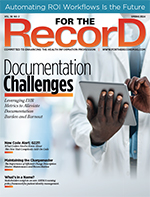Spring  2024 Issue
2024 Issue
Revenue Cycle Management: Best Practice Advice: Implementing RPA in the Revenue Cycle
By Mark S. Rodi, MSHA
For The Record
Vol. 36 No. 2 P. 30
Now is the time for revenue cycle leaders to venture beyond new technology concerns and explore an ocean of opportunity for robotic process automation.
With the many challenges plaguing the health care industry over the past few years, the promise of new technology offers financial relief for health care executives looking to combat staffing and workload concerns. However, some executives are still wary of emerging technologies, such as artificial intelligence (AI) and robotic process automation (RPA), with limited use cases to encourage implementation into their workflows.
The conundrum for health care revenue cycle leaders is familiar. Staffing challenges are pervasive, but nascent revenue cycle automation technology is unproven. Do health care leaders roll the dice with staffing shortages or invest in AI and RPA solutions to automate revenue cycle processes?
As these uncertainties percolate, one certainty remains. Accelerating cash flow is paramount. And to achieve this vital goal, executives must view RPA as a serious option and critical driver for revenue cycle management success. Consider the lessons learned and best practice advice from implementation of RPA at a large academic medical center in the Northeast.
Is RPA the Right Fit?
Being in touch with your team and interrelated departments is the first key to evaluating RPA as an effective option for your revenue cycle. In departmental conversations and operational meetings, RPA will likely arise in discussions with front-line staff. Proactive leaders who are in touch with their staff’s day-to-day struggles will understand clearly that the need for RPA is apparent within their teams.
For example, revenue cycle departments that experience staffing shortages, consistent changes in regulatory compliance requirements, credentialing burdens, onerous quality reporting deadlines, and denials due should already be discussing RPA’s potential to solve these persistent operational challenges. Savvy leaders understand the urgent pleas from their staff and are evaluating automation to fill workflow gaps.
In my experience as a leader of revenue cycle operations at a large academic medical center, these realities were real. And they were expressed regularly during team huddles and department management meetings.
Implementation—Where and for What?
Leaders who take inventory of their teams can spotlight routine and transactional tasks. These revenue cycle tasks are prime candidates for automation. If your staff performs the same keystrokes and the task is repetitive and transactional, then RPA should be considered.
The use of RPA in the revenue cycle delivered the following benefits at our organization:
• increased staff efficiency;
• improved staff satisfaction;
• decreased workforce turnover;
• significant improvements in KPIs;
• prioritization of higher value accounts;
• transactions beyond the 40-hour workweek; and
• automations scaled for future development and expansion.
We achieved these benefits by listening to teams and choosing the right processes to automate.
Best RPA Implementation Advice
Leaders must advocate for educated RPA resources and technology vendors. Having experts attend daily management and operational meetings provides clarity in the departmental state of teams and ensures your RPA vendors hear staff concerns and opportunities for automation. Best practice is to have vendors sit side by side with staff to record each keystroke across a revenue cycle process. This essential step ensures end users provide actionable design specifications needed by the vendor to design effective RPA bots.
Vendor and staff should work together to design and test the bot, making sure it mimics human behavior within its designated operations. Bots must also be put through change control processes with full staff auditing of technology prior to implementation into the desired system. Although the design and build of a productive RPA bot sounds tedious, the process often takes less than a week.
Following implementation, a tight partnership between the RPA vendor and end users is required. Once the bot is integrated into the system, daily monitoring within software control centers to view its operations is imperative. Here, controls are put into place for the potential occurrences of the bot side-stepping its design and rulings, halting continual inaccuracies. Once an error is detected by the monitoring end user, the RPA vendor can investigate and reprogram to prevent further errors from occurring.
Where Not to Introduce RPA
Although revenue cycle departments benefit greatly from implementing RPA into their staff workflows, this is only recommended for the mundane, repetitive, transactional tasks. Do not introduce workflow automation for every departmental task. Certain workflows are not bot friendly. This includes tasks and workflows that require human logic or operational complexity.
The use of RPA bots may seem like an automated revenue acceleration for all operations, but it is not always the right choice for complex cases.
Making Sense of RPA in Revenue Cycle
RPA allows revenue cycle teams to see quick impact and proven return on investment. Relieved from burdensome and repetitive tasks, staff turn their attention to other, value-add functions where human expertise and knowledge are required to accelerate cash flow.
Now is the time for revenue cycle leaders to venture beyond the uncertainty of RPA, identify specific areas for automation, and resolve their revenue cycle staffing challenges through technology.
— Mark S. Rodi, MSHA, is an experienced health care leader with more than 30 years of industry experience. Prior to joining e4health in 2023, he served in a variety of revenue cycle leadership roles with prestigious health care organizations in central Pennsylvania and the greater Philadelphia area.
Robotic Process Automation Best Practices
• Encourage front-line staff to determine automation opportunities.
• Partner front-line staff with technology experts to develop bots.
• Measure the return on investment for each implemented bot.
• Socialize the use and results of your automation strategy.
• Require a rigorous quality assurance process for every bot implemented.
• Incorporate your robotic process automation processes into the change control process.
• Do not force every workflow into an automation.



